Basic engagement actions
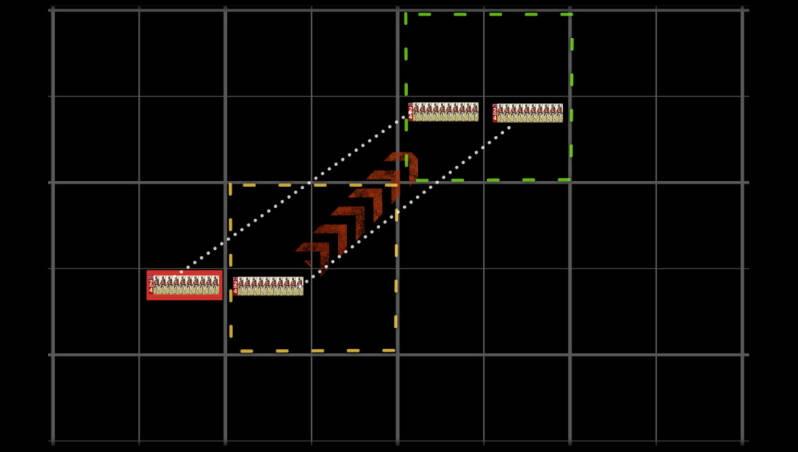
Movement
Each type of unit possesses a specified range of movement from its central point. Units are capable of maneuvering in any direction on the battlefield using the operational zones for movement (big squares), contingent upon the suitability of the terrain. To relocate an individual unit or a battlegroup, simply transfer them from one operational zone to another within their designated movement range. This action incurs at the cost of a single action point. When two units, whether individually or a battle group, are positioned between two operational zones, it means both units are stationed at the midpoint of these zones. Should the units be reassigned to an alternate operational zone, both units can relocate as one unit to the new location and engage if in range, using one action. This arrangement facilitates the seamless relocation of units deployed between operational zones, thereby enhancing the mobility of units and battlegroups.
Movement and engagement
Unit movement can be combined with engagement actions, provided the units are within effective range for such maneuvers. This combination; movement followed by an engagement, can also be executed in reverse order and for the use of one action point. This tactic can be implemented for individual units as well as for units organized into battle groups.
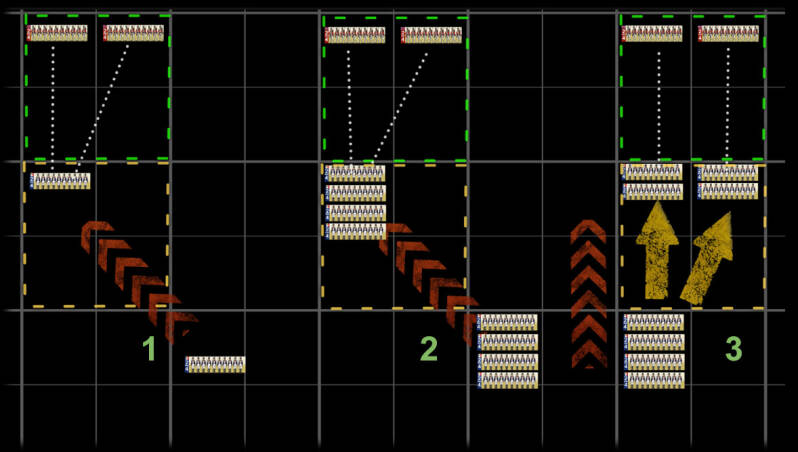
In Situation 1, a light infantry unit advances one operational zone to come within target range of enemy forces. Upon reaching the designated location, the unit is authorized to open fire by rolling the appropriate dice and utilizing one action point. In Situation 2, a brigade of four infantry battalions moves one operational zone to bring itself within firing range of enemy units. The brigade’s front line consists of light infantry which, upon arrival at the new position, engage and target opposing units using one action point. In Situation 3, a brigade is repositioned forward by one operational zone and subsequently deploys in a double-line formation. If both front-line units are within range of enemy targets upon deployment, they may engage those targets simultaneously using two action points.
It is crucial to understand that the range of movement is consistently measured in operational zones (the larger squares). In contrast, for infantry units, the charging and targeting range is determined by the engagement square (the smaller squares). An exception exists for cavalry units, where their charge range is also measured in operational zones to facilitate a more straightforward calculation of engagement squares. In summary, it is crucial to note that single units or battle groups deployed in their new operational zone have the capability to charge or target fire at units beyond the confines of their designated engagement zone, provided they are within range for engagement. Consequently, it is essential to ensure that the formation and order of battle for these battle groups are appropriately aligned with their mission objectives. For each subsequent action or engagement, whether involving an individual unit or multiple units within a battle group, one action point must be expended.
Engage and retreat
Consider a scenario where an infantry unit is already within effective engagement range; it could first fire upon or charge at an enemy position and then relocate to another operational zone for safety. Since the unit has not yet moved prior to attacking, it retains its ability to reposition post-engagement, using one action point for the maneuver.
Firing
Engaging targets with fire abilities like infantry and artillery, necessitates the expenditure of one action point for each individual unit or units in battle group formation. Indicate the targeted unit and roll the appropriate dice to determine the outcome of the engagement. If successful, place a damage marker on the targeted unit according to the attack value of your engaging force.
Firing with infantry
Line infantry units are effective at targeting adversaries within one engagement square (smaller square), whereas light and elite infantry can reach enemy units situated within two engagement squares. The direction of fire may be freely chosen and at the expenditure of one action point. To engage in firing with the infantry, point your targeted unit and roll the dice corresponding to that unit's class to determine the outcome. Upon a successful roll, assign damage markers to the targeted unit’s display to indicate inflicted damage.
Firing with the artillery
Engaging enemy units with a single artillery battery or a battery deployed in group formation requires one action point. Artillery units possess the capability to engage targets located up to four operational zones distant, extending to five zones if the battery is positioned on elevated terrain, indicated by a red artillery icon. Artillery can combine movement and firing effectively. For example, if a target is five operational zones away, but the artillery cannot reach elevated ground, it may advance one square forward, bringing the target within four operational zones for engagement. Thus, by moving an operational zone and then firing, the artillery can strike the enemy while expending only one action point. In defensive scenarios, if infantry units are closing in within one operational distance and pose an imminent threat to attack in the next round, the artillery unit may first deliver damage using a canister shot before retreating to a safer position, all within the cost of one action point.
To initiate gunfire with the artillery, simply point out on the battlefield the targeted unit and tell how the artillery is to be used, as regular long range artillery, howitzer to target units inside building then roll the corresponding artillery dice to determine the outcome. However, for short-range engagements with canister shots, the damage inflicted is predetermined. Such engagements guarantee a damage of 3 points to the targeted unit without requiring a dice roll. Unlike infantry units, which cannot fire over other units when deployed one behind another, the artillery maintains this ability under similar conditions. This principle remains valid provided the artillery is not engaged in firing canister shots, whether they are deployed in column or line formation.
Charge/ melee combat
Charging is a strategic maneuver utilized by cavalry and infantry units. In melee combat between units of the same class, the unit that initiates the charge gains the upper hand, with inflicted damage according to their respective classes. Should a commander decide to hold ground post-charge, any surviving enemy unit must retreat and vacate the occupied engagement square (smaller grid). Units of a lower class cannot execute charges against higher-class units unless they commence within range of command of a general, simulating a boosted morale of the unit. It is important to note that both artillery and ambulance wagons are not designed for, nor capable of, engaging in charges or close-quarter combat scenarios.
Charging with infantry
To initiate a charge against an enemy unit with infantry, select a target within range and move your unit into engagement position. The outcome of a charge attack does not require dice rolls; it is always successful and results in guaranteed damage. The charging distance for infantry units represents a distinct maneuver and should not be confused with their standard movement range, both being distinct elements within the game's mechanics.
Charging with cavalry
With their 3 operational zones in any direction as movement range, the cavalry is able to be positioned quickly on the battlefield. Moving a single cavalry unit or group of cavalry is at the cost of one action point. If the cavalry is able to charge an enemy unit or position within their range, they may combine the movement with an attack by charging. Cavalry units are permitted to execute one charge per turn, whether they function independently or as part of a battle group; this mirrors the fatigue experienced by the horses following each charge.
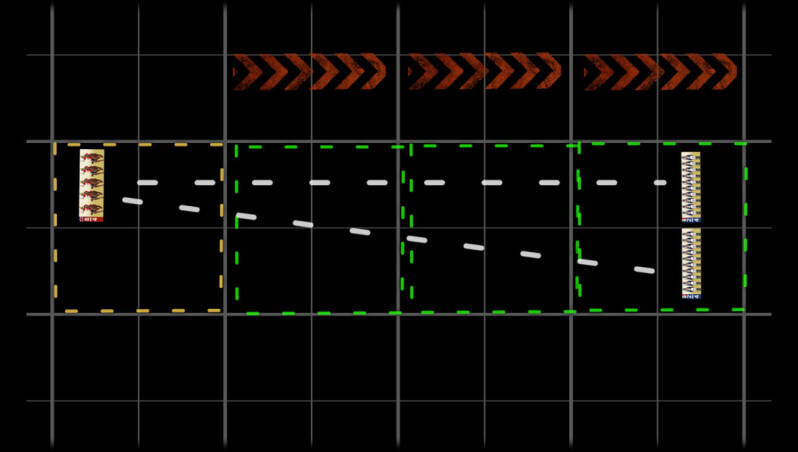
To ensure the execution of an effective charge, it is imperative that the cavalry maintains a minimum distance of one operational zone between its unit and the target at all times. Additionally, the trajectory of the charge must be linear unless roadways are utilized to approach the target. The cavalry is unable to engage units that are encircled by buildings, forests or any other discernible obstacles. It is imperative that the route to the targeted units remains unobstructed at all times.
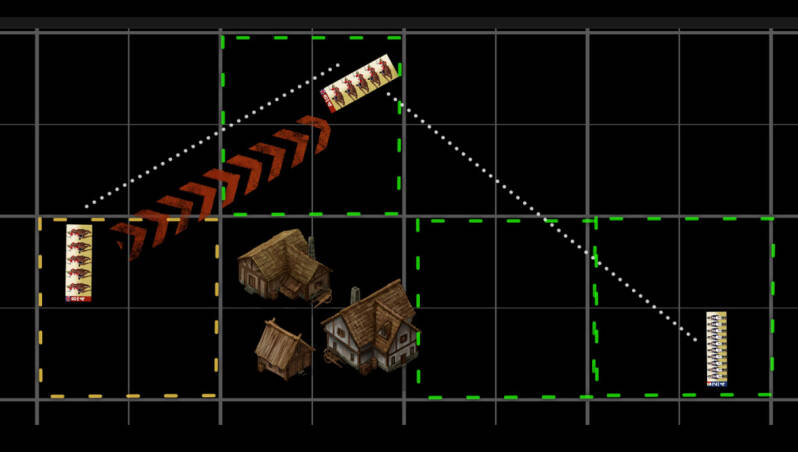
Another example involves situations where a direct line-of-charge is obstructed. By relocating one operational zone to another position, the cavalry can realign itself and launch a straight-line charge on an enemy target located 2 squares from their new stance. This maneuver consumes one action point but enables successful repositioning and charging within permissible movement-attack combinations for the cavalry.
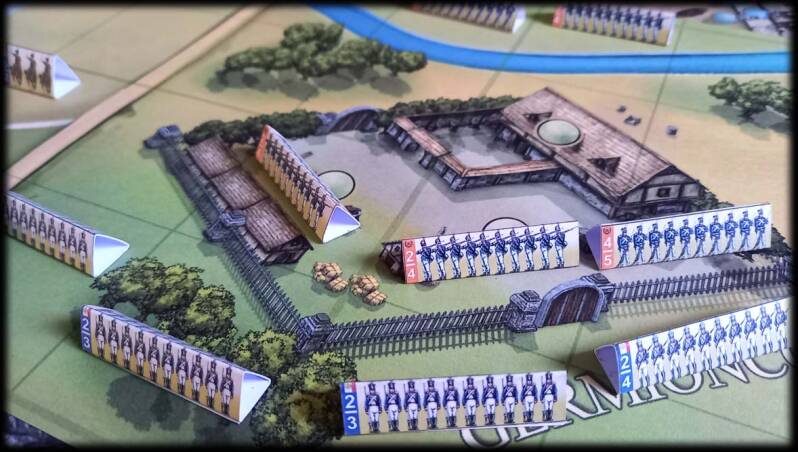
Occupy buildings
Infantry charges are an effective strategy for securing territory or clearing buildings occupied by enemy forces. Unlike artillery, which cannot charge and cavalry which cannot enter buildings, infantry units are uniquely capable of performing this essential task. To execute a charge, the infantry unit must advance to the engagement square currently occupied by opposing forces. Upon a successful charge, if the defending unit is not eliminated but survives, it must vacate the engagement square. Consequently, control of this area or building is now under your command until any counter-charges or actions occur.

